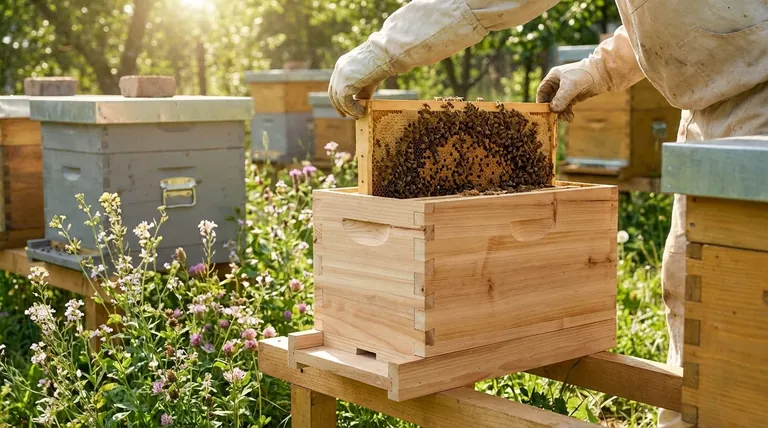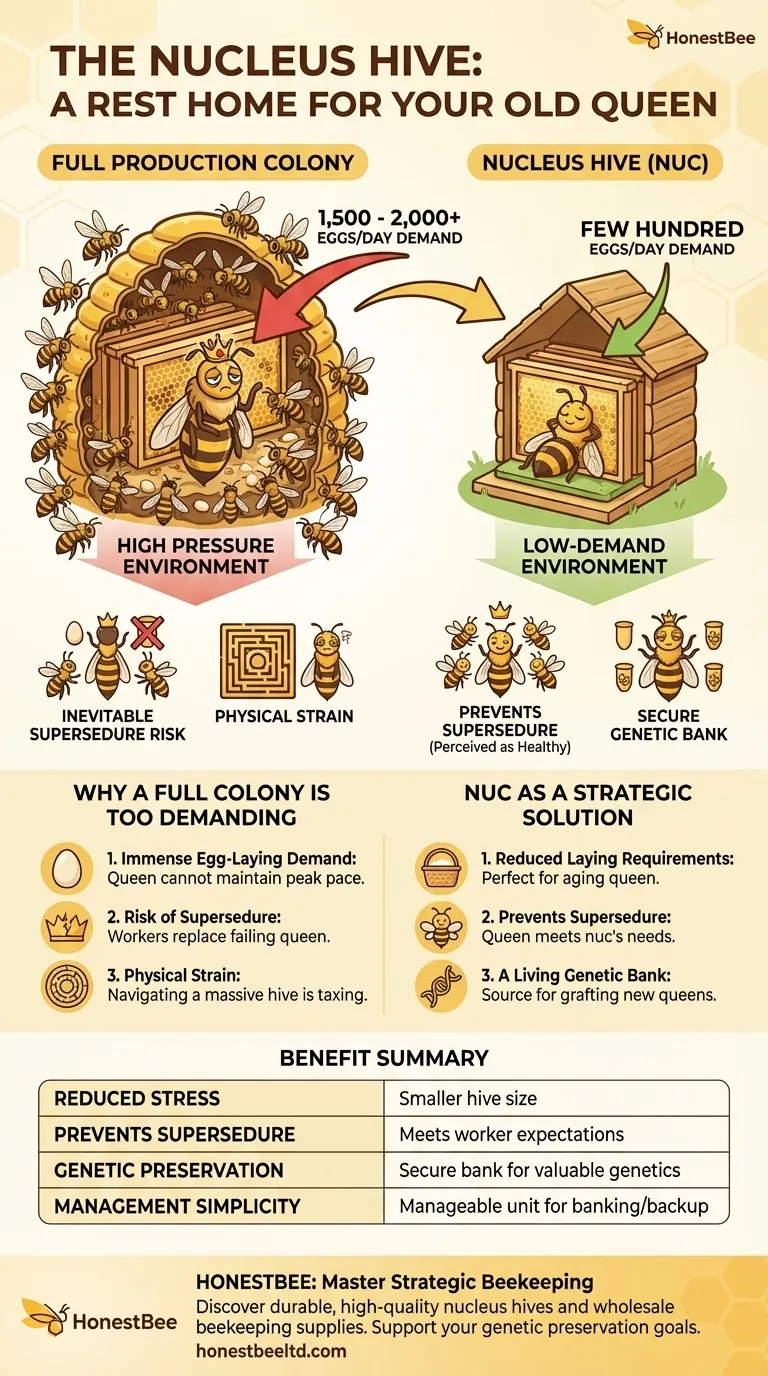At its core, a nucleus hive serves as a 'rest home' for an old queen by creating a low-demand environment that matches her declining productivity. Instead of forcing her to manage the immense needs of a full-production colony, the smaller nucleus hive allows her to continue laying at a reduced, comfortable pace. This preserves her valuable genetics and extends her productive life without the stress that would otherwise lead to her replacement.
This strategy is not about sentimentality; it is a calculated beekeeping practice. By moving a proven but aging queen to a nucleus hive, you transform her from a potential liability in a large colony into a secure genetic asset for your apiary.

Why a Full Colony Becomes Too Demanding
As a queen ages, her ability to lay eggs and produce the pheromones that signal her vitality naturally declines. In a large, thriving colony, this decline creates significant problems.
The Immense Egg-Laying Demand
A full-sized production hive at its peak requires its queen to lay 1,500 to 2,000+ eggs per day. This is necessary to replace aging workers and expand the colony's population for a honey flow. An older queen simply cannot maintain this demanding pace.
The Inevitable Risk of Supersedure
Worker bees constantly assess their queen's performance. If her egg-laying rate drops or her pheromone output weakens, they perceive her as failing. This triggers a natural process called supersedure, where the workers raise a new queen to replace the old one. For the beekeeper, this means the loss of a proven queen and her desirable genetics.
The Physical Strain of a Large Hive
Navigating a massive hive with ten or more deep frames is physically taxing. An older queen must constantly move across this vast area to find prepared cells for laying, which becomes increasingly difficult as her physical strength wanes.
The Nucleus Hive as a Strategic Solution
A nucleus hive, or "nuc," fundamentally changes the dynamic. It is typically a small hive of three to five frames that perfectly accommodates the reduced capacity of an aging queen.
Reduced Laying Requirements
The population of a nucleus hive is a fraction of a full colony's. Therefore, it only needs a few hundred eggs per day to sustain itself. An older queen who can no longer meet the demands of a large hive can easily satisfy the needs of a nuc.
Preventing Supersedure by Meeting Expectations
Because the queen is able to lay enough eggs to fill the available brood space in the small nuc, the workers perceive her as healthy and productive. This removes the primary trigger for supersedure, allowing the beekeeper to keep the queen safe and productive.
A Living Genetic Bank
The most powerful reason to use this technique is to preserve valuable genetics. If a queen has consistently produced gentle bees with excellent honey production or disease resistance, she is a vital asset. The nuc acts as a safe house, ensuring you have a reliable source of her eggs and larvae for grafting new queens.
Understanding the Trade-offs
While this is a powerful technique, it is essential to understand its purpose and limitations.
This is Not a Production Unit
A nucleus hive housing an old queen is a queen bank, not a honey production colony. It will not create a surplus of honey and may even require supplemental feeding to ensure its survival, as its small population cannot forage as effectively.
Management is Still Required
A nuc is small, but it is not a "set it and forget it" system. You must still perform regular inspections to ensure the queen has space to lay and that the colony doesn't become honey-bound, which could lead to swarming.
It Is a Finite Solution
This strategy extends a queen's productive life; it does not make her immortal. Eventually, she will fail completely. The goal is to maximize the time you have to raise daughter queens from her superior genetics.
How to Apply This to Your Apiary
Using a nucleus hive for an aging queen is a hallmark of proactive, strategic beekeeping. The decision to do so should align with your specific goals.
- If your primary focus is preserving valuable genetics: Move the proven queen to a nuc before her production drops enough to trigger supersedure in her large colony. Use her as a source for grafting new queens to head other hives.
- If your primary focus is having a backup queen: Maintaining a proven, older queen in a nuc provides you with a ready-made solution should another colony unexpectedly become queenless.
- If your primary focus is simply protecting a favorite queen: This method allows a queen with desirable traits, such as gentleness, to live out her final season in a safe, low-stress environment.
Ultimately, this practice empowers you to be a manager of genetics, not just a manager of bees.
Summary Table:
| Benefit | Description |
|---|---|
| Reduced Stress | Smaller hive size matches the queen's declining egg-laying pace. |
| Prevents Supersedure | Meets worker expectations, eliminating the trigger for replacement. |
| Genetic Preservation | Acts as a secure bank for valuable genetics from proven queens. |
| Management Simplicity | Provides a manageable unit for queen banking and backup purposes. |
Ready to master strategic beekeeping and preserve your best queen genetics?
As a beekeeper focused on the long-term health and productivity of your apiary, having the right equipment is crucial. A well-built nucleus hive is the key tool for implementing this powerful queen-management technique.
HONESTBEE supplies commercial apiaries and beekeeping equipment distributors with the durable, high-quality supplies needed for success. We understand the demands of modern beekeeping and provide wholesale-focused solutions to help you manage your colonies effectively.
Let's discuss how our nucleus hives and other equipment can support your genetic preservation goals. Contact our team today to learn more about our products and wholesale pricing.
Visual Guide

Related Products
- 5 Frame Wooden Nuc Box for Beekeeping
- Plastic Chinese Queen Grafting Tool for Bee Queen Rearing
- HONESTBEE Advanced Ergonomic Stainless Steel Hive Tool for Beekeeping
- HONESTBEE Professional Long Handled Hive Tool with Precision Cutting Blade
- Automatic Honey Flow Beehive 4 Frame Mini Hive for Beekeeping
People Also Ask
- What frames should be moved into the queenless hive when requeening with a nuc? Ensure a Successful Queen Introduction
- How many frames does a typical wooden nuc box hold? A Guide to Choosing the Right Size
- How should the nuc be installed in the apiary? Ensure Colony Success from Day One
- What is the purpose of having a nuc in beekeeping? Build a Resilient & Productive Apiary
- What is a common feature of many 5-frame nuc boxes? The Integrated Feeder for Efficient Colony Growth



















